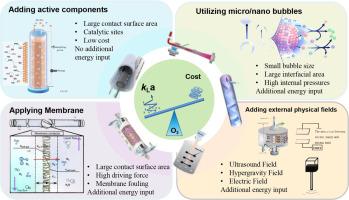强化臭氧气/液传质和臭氧化效率:综述
IF 12.4
1区 环境科学与生态学
Q1 ENGINEERING, ENVIRONMENTAL
引用次数: 0
摘要
臭氧(O3)对废水中持久性有机污染物的降解是有效的,但其效率受到O3气液传质差(kLa)和O3利用率低(气泡塔一般为30% ~ 64%)的限制。这篇综述批判性地评估了加强O3传质和加强污染物降解的策略。比较了不同常用臭氧接触器的kLa和能耗,强调了开发增强方法的重要性。在此基础上,以kLa增强系数、污染物降解效率和可扩展性为标准,对四种技术(应用物理场、实施膜技术、利用微纳气泡和添加添加剂)进行了评价。物理方法(包括超声、电场和高重力)将kLa提高了1.3-3倍,但由于高能量需求,面临可扩展性挑战。微/纳米气泡产生系统与催化剂(如活性炭或化学添加剂)相结合,可将kLa提高3-4倍,将难降解污染物的去除率提高60%以上。然而,微泡的产生也需要额外的能量和化学添加剂,可能造成二次污染。天然矿物填料提供了平衡的解决方案,在低能耗的情况下,将kLa提高2.5-3倍,将顽固污染物去除25-30%,没有二次分离问题。在可扩展性方面,膜接触器和催化微泡已在大规模废水处理中得到应用,但膜和催化剂的稳定性有待进一步提高。总体而言,本研究确定了可持续水处理中O3气/液传质和污染物去除的有利策略。本文章由计算机程序翻译,如有差异,请以英文原文为准。

Intensification of ozone gas/liquid mass transfer and ozonation efficiency: a critical review
Ozone (O3) is effective for degrading persistent organic pollutants in wastewater but its efficiency is limited by poor O3 gas/liquid mass transfer (kLa) and low O3 utilization efficiency (typically 30%-64% in bubble columns). This review critically evaluates strategies to intensify O3 mass transfer and enhance pollutant degradation. The kLa and energy consumption in different commonly used ozone contactors was compared, highlighting the importance of developing enhancement methods. Based on this, four types of techniques (i.e. applying physical fields, implementing membrane technology, utilizing micro/nano bubbles, and adding additives) were evaluated using kLa enhancement factor, pollutant degradation efficiency, and scalability as criteria. Physical methods (including ultrasound, electric field, and high gravity) enhanced kLa by 1.3–3 times but face scalability challenges due to high energy demands. Micro/nano-bubble producing systems coupled with catalysts such as activated carbon or chemical additives achieved kLa enhancements 3-4 times, increasing degradation of refractory pollutants by over 60% removal. However, the microbubble generation also demands additional energy and chemical additives may cause secondary pollution. Natural mineral packings provide a balanced solution, enhancing kLa by 2.5–3 times and recalcitrant pollutant removal by 25–30% at low energy consumption without secondary separation issues. For scalability, membrane contactors and catalytic microbubble have been applied at large-scale wastewater treatment while the stability of membrane and catalysts needs to be further improved. Overall, this study identifies favorable strategy for O3 gas/liquid mass transfer and pollutant removal for sustainable water treatment.
求助全文
通过发布文献求助,成功后即可免费获取论文全文。
去求助
来源期刊

Water Research
环境科学-工程:环境
CiteScore
20.80
自引率
9.40%
发文量
1307
审稿时长
38 days
期刊介绍:
Water Research, along with its open access companion journal Water Research X, serves as a platform for publishing original research papers covering various aspects of the science and technology related to the anthropogenic water cycle, water quality, and its management worldwide. The audience targeted by the journal comprises biologists, chemical engineers, chemists, civil engineers, environmental engineers, limnologists, and microbiologists. The scope of the journal include:
•Treatment processes for water and wastewaters (municipal, agricultural, industrial, and on-site treatment), including resource recovery and residuals management;
•Urban hydrology including sewer systems, stormwater management, and green infrastructure;
•Drinking water treatment and distribution;
•Potable and non-potable water reuse;
•Sanitation, public health, and risk assessment;
•Anaerobic digestion, solid and hazardous waste management, including source characterization and the effects and control of leachates and gaseous emissions;
•Contaminants (chemical, microbial, anthropogenic particles such as nanoparticles or microplastics) and related water quality sensing, monitoring, fate, and assessment;
•Anthropogenic impacts on inland, tidal, coastal and urban waters, focusing on surface and ground waters, and point and non-point sources of pollution;
•Environmental restoration, linked to surface water, groundwater and groundwater remediation;
•Analysis of the interfaces between sediments and water, and between water and atmosphere, focusing specifically on anthropogenic impacts;
•Mathematical modelling, systems analysis, machine learning, and beneficial use of big data related to the anthropogenic water cycle;
•Socio-economic, policy, and regulations studies.
 求助内容:
求助内容: 应助结果提醒方式:
应助结果提醒方式:


